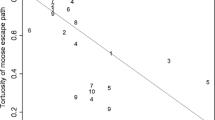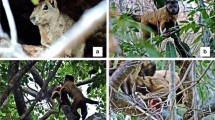Abstract
Mammalian carnivores are unusual because their primary competitors for food are often their primary predators. This relationship is most evident at persistent kills where dominant competitors are attracted to both the carcass (as a free meal) and to the killers (as potential prey). Cheetahs (Acinonyx jubatus) are frequent victims of kleptoparasitism, and cubs, and sometimes adults, are killed by lions (Panthera leo) or spotted hyenas (Crocuta crocuta). Between 1980 and 2002, we observed 639 kills made by cheetahs in Serengeti National Park, Tanzania. These kills were often visited by scavengers, including relatively innocuous species such as vultures and jackals and potentially dangerous species, like spotted hyenas and lions. We used cheetah behavior at kills to test a number of predictions about how cheetahs should minimize risk at kill sites given they face an increased risk of predation of themselves or their cubs. In particular, we examined the propensity of cheetahs of different age/sex classes to hide carcasses after making a kill, vigilance at kills, and the delay in leaving after finishing feeding with respect to ecological factors and scavenger presence. The behavior of single females at kills did not suggest that they were trying to avoid being killed, but the behavior of males, often found in groups, was in line with this hypothesis. In contrast, the behavior of mother cheetahs at kills appeared to be influenced greatly by the risk of cubs being killed. Our results suggest that cheetahs use several behavioral counterstrategies to avoid interspecific predation of self or cubs.
Similar content being viewed by others
References
Bednekoff PA, Lima SL (1998) Re-examining safety in number: interaction between risk dilution and collective detection depend on predator targeting behaviour. Proc R Soc Lond 265:2021–2026
Blumenschine R (1986) Early hominoid scavenging opportunities: implications of carcass availability in the Serengeti and Ngorongoro ecosystems. BAR International Series 283, Oxford
Blumenschine R J, Caro TM (1986) Unit flesh weights of some East African bovids. Afr J Ecol 24:273–286
Brown JS, Laundre JW, Gurung M (1999) The ecology of fear: optimal foraging, game theory and tropic interactions. J Mammal 80:385–399
Burney DA, Burney L (1979) Cheetah and man. Swara 2:24–29
Carbone C, du Toit JT, Gordon IJ (1997) Feeding success in African wild dogs: does kleptoparasitism by spotted hyenas influence hunting group size? J Anim Ecol 66:318–326
Caro TM (1987) Cheetah mothers’ vigilance: looking out for prey or predators? Behav Ecol Sociobiol 20:351–361
Caro TM (1989) Determinants of asociality in felids. In: Standen V, Foley RA (eds) Comparative socioecology: the behavioural ecology of humans and other mammals. Blackwell Scientific Publications, Oxford, pp 41–74
Caro TM (1994) Cheetahs of the Serengeti Plains. University of Chicago Press, Chicago
Caro TM (2005) Anti-predator defenses in birds and mammals. University of Chicago Press, Chicago
Clutton-Brock TH (1991) The evolution of parental care. Princeton University Press, Princeton
Cooper SM (1991) Optimal hunting group size: the need for lions to defend their kills against loss to spotted hyaenas. Afr J Ecol 29:130–136
Cullen J (1960) Some adaptations in the nesting behavior of terns. Proc XII Int Ornithol Congr 1958:153–157
Dominguez-Rodrigo M (2001) A study of carnivore competition in riparian and open habitats of modern savannas and its implications for hominid behavioral modelling. J Hum Evol 40:77–98
Donadio E, Buskirk SW (2006) Diet, morphology and interspecific killing in Carnivora. Am Nat 167:524–536
du Pienaar UV (1969) Predator–prey relationships amongst the larger mammals of the Kruger National Park. Koedoe 12:108–176
Durant SM (1998) Competition refuges and coexistence: an example from Serengeti carnivores. J Anim Ecol 67:370–386
Durant SM (2000a) Living with the enemy: avoidance of hyenas and lions by cheetahs in the Serengeti. Behav Ecol 11:621–632
Durant SM (2000b) Predator avoidance, breeding experience and reproductive success in endangered cheetahs. Anim Behav 60:121–130
Eaton RL (1974) The Cheetah: biology, ecology and behaviour of an endangered species. Van Nostrand Reinhold, New York
Elgar MA (1989) Predator vigilance and groups size in mammals and birds: a critical review of the empirical evidence. Biol Rev 64:13–33
Fanshawe JH, Fitzgibbon CD (1993) Factors influencing the hunting success of an African wild dog hunting group. Anim Behav 45:479–490
Frame G, Frame L (1981) Swift and enduring. Elsevier-Dutton, New York
Hilton GM, Ruxton GD, Cresswell W (1999) Choice of foraging area with respect to predation risk in redshanks: the effects of weather and predator activity. Oikos 87:295–302
Houston DC (1975) Ecological isolations of African scavenging birds. Ardea 63:55–64
Kelly MJ (2000) The Serengeti cheetah population: individual identification, demography and viability (PhD dissertation). University of California, Davis
Kelly MJ, Durant SM (2000) Viability of the Serengeti cheetah population. Conserv Biol 14:786–797
Kelly MJ, Laurensen MK, FitzGibbon CD, Collins DA, Durant SM, Frame GW, Bertram BCR, Caro TM (1998) Demography of the Serengeti cheetah (Acinonyx jubatus) population: the first 25 years. J Zool 244:473–488
Kruuk H (1967) Competition for food between vultures in East Africa. Ardea 55:171–192
Laurenson MK (1994) High juvenile mortality in cheetahs (Acinonyx jubatus) and its consequences for maternal care. J Zool 234:387–408
Laurenson MK (1995) Implications of high offspring mortality for cheetah population dynamics. In: Sinclair ARE, Arcese P (eds) Serengeti II: dynamics, management and conservation of an ecosystem University of Chicago Press, Chicago, pp 385–399
Lima S (1988) Initiation and termination of feeding in dark-eyed juncos influences of predation risk and energy reserves. Oikos 53:3–11
Lima S (1998) Stress and decision making under the risk of predation: recent developments from behavior, reproductive and ecological perspectives. Adv Stud Behav 27:215–290
Lima SL, Dill LM (1990) Behavioural decisions made under the risk of predation: a review and prospectus. Can J Zool 68:619–640
Martin J, Lopez P, Cooper WE (2003) When to come out from a refuge: balancing predation risk and foraging opportunities in an alpine lizard. Ethology 109:77–87
Montgomerie RD, Weatherhead PJ (1988) Risks and rewards of nest defense by parent birds. Q Rev Biol 63:167–187
Packer C (1986) The ecology of sociality in felids. In: Rubenstien DL, Wrangham RW (eds) Ecological aspects of social evolution: birds and mammals. Princeton University Press, Princeton, pp 429–451
Palomares F, Caro TM (1999) Interspecific killing among mammalian carnivores. Am Nat 154:492–508
Payne RW, Lane PW, Ainsley AE, Bicknell KE, Digby PGN, Harding SA, Lech PK, Simpson HR, Todd AD, Verrier PJ, White RP, Gower JC, Tunnicliffe Wilson G, Paterson LJ (1987) GENSTAT 5 Reference manual. Oxford University Press, Oxford
Schaller G (1972) The Serengeti lion: a study of predator–prey relations. University of Chicago Press, Chicago
Sih A (1986) Antipredator responses and the perception of danger by mosquito larvae. Ecology 67:434–441
Sih A (1987) Predators and prey lifestyles: an evolutionary and ecological overview. In: Kerfoot WC, Sih A (eds) Predation: direct and indirect impacts on aquatic communities. University Press of New England, Hanover, pp 203–224
Stander PE, Haden PJ, Kaqece, Ghau (1997) The ecology and asociality in Namibian leopards. J Zool 242:343–364
Sunquist ME, Sunquist FC (1989) Ecological constraints on predation by large felids. In: Gittleman JL (ed) Carnivore behavior, ecology and evolution. Cornell University Press, Ithaca, pp 283–301
Swetitzer RA, Berger J (1992) Size-related effects of predatoni on habitat use and behavior of porcupines (Erethizon drsatum). Ecology 73:867–875
Switalski TA (2003) Coyote foraging ecology and vigilance in response to gray wolf reintroduction in Yellowstone National Park. Can J Zool 81:985–993
Vine I (1973) Detection of prey flocks by predators. J Theor Biol 40:207–210
Werner EE, Gilliam JF, Hall DJ, Mittlebach GG (1983) An experimental test of the effects of predation risk on habitat use in fish. Ecology 64:1540–1548
Winkler DW (1987) A general model for parental care. Am Nat 130:526–543
Yamane A, Emoto J, Ota N (1997) Factors affecting feeding order and social tolerance to kittens in the group living feral cat. App Anim Behav Sci 52:119–127
Acknowledgment
We thank the Tanzania Commission for Science and Technology, Tanzania Wildlife Research Institute, and Tanzania National Parks for permission. We thank Lindsay Turnbull, Isla Graham, Jos Milner, Jane Wisbey, Ian and Ghislaine Sayers, John Shemkunde, and Sultana Bashir for help with data collection. Funding was provided to JSH by the National Science Foundation and the University of California, to SMD by Wildlife Conservation Society, Frankfurt Zoological Society, National Geographic Society, Peoples Trust for Endangered Species, the Howard Buffett Foundation and the Times Christmas Appeal 1998, and to TMC by the Royal Society and the National Geographic Society. SMD is grateful to everyone at SWRC, SENAPA, the late Hugo van Lawick and his team, Frankfurt Zoological Society, Greg and Maria Russell, and Ndutu lodge for logistical support during fieldwork. This study was conducted in full compliance with the laws and regulations governing scientific study in Tanzania.
Author information
Authors and Affiliations
Corresponding author
Additional information
Communicated by T. Bakker
Rights and permissions
About this article
Cite this article
Hunter, J.S., Durant, S.M. & Caro, T.M. To flee or not to flee: predator avoidance by cheetahs at kills. Behav Ecol Sociobiol 61, 1033–1042 (2007). https://doi.org/10.1007/s00265-006-0336-4
Received:
Revised:
Accepted:
Published:
Issue Date:
DOI: https://doi.org/10.1007/s00265-006-0336-4




